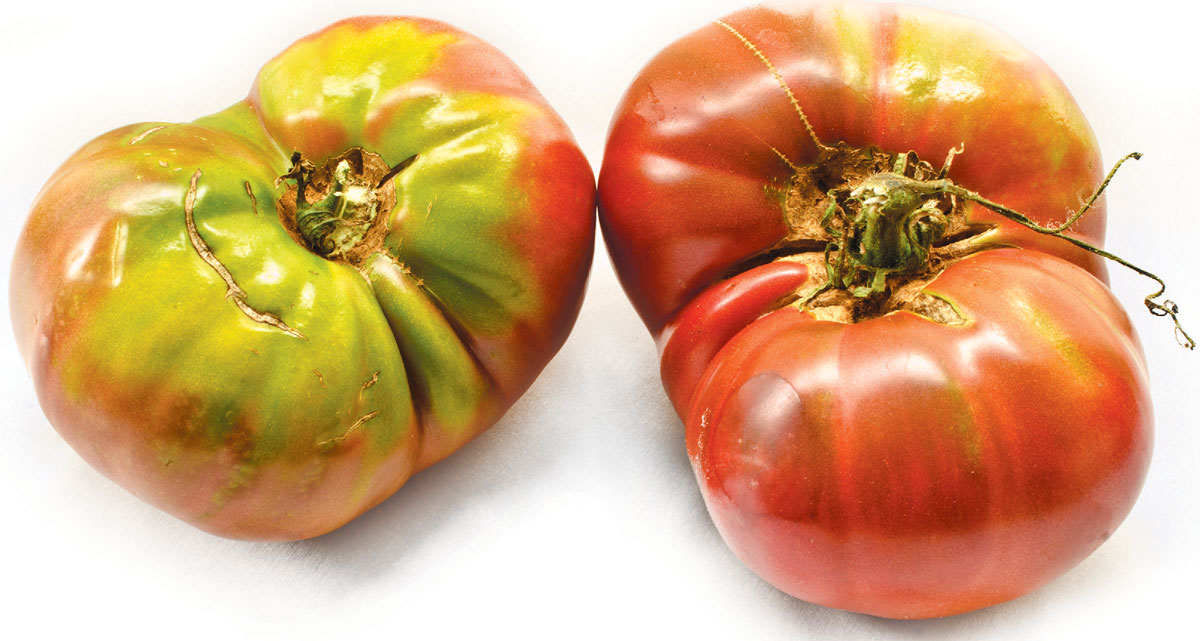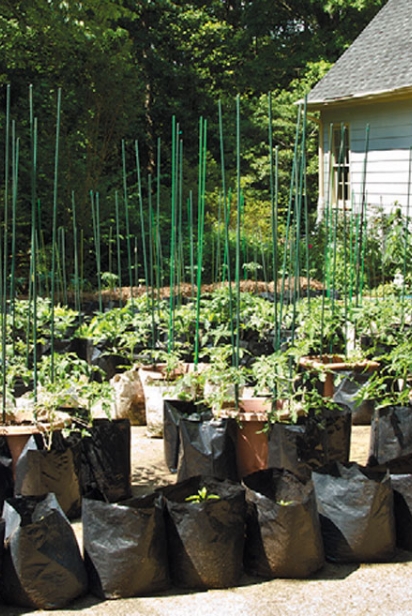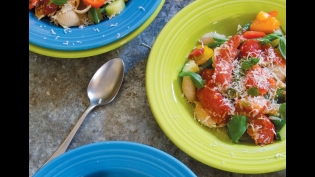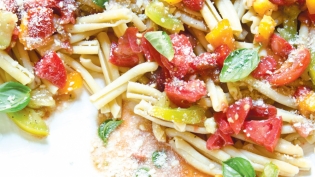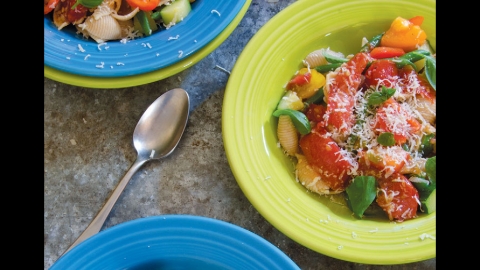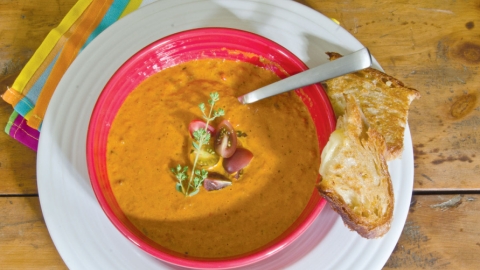Growing Heirlooms: The Tomato Man, the Farmer, and the Cherokee Purple
In the quaint days before online dating, people used to actually talk to each other. When they weren’t located close enough to share tender secrets, they’d write letters, sharing locks of hair and pressed flowers meant to preserve the bloom of love.
To an extent, it’s still that way among passionate growers of heirloom fruits and vegetables. They communicate as they have for decades, mailing thoughtful notes and treasured packets of saved seeds with those they trust.
It was little surprise, perhaps, that John D. Green of Sevierville, Tennessee, took a chance in 1990 and sent some of his favorite seeds to Pennsylvania, where they landed in the mailbox of a pharmaceutical chemist. The recipient was a backyard gardener who enjoyed sharing a hobby with his bride.
Craig LeHoullier, who later settled in North Raleigh, set about sowing Green’s Cherokee Purple seeds right away. Considered by many as the first of the nearly black tomatoes, he was as intrigued by its color - which a friend likened to a leg bruise — as its deep flavor and disease resistant nature. Year after year, its yield was consistent, not only in his northern garden, but also in those of countless colleagues with whom he traded seeds.
“I’m pretty lucky that this tomato found me,” says LeHoullier, author of Epic Tomatoes, who is credited with bringing the heirloom variety to such prominence that it’s commonly sold at farmers markets around the world.
“In fact, I feel like it chose me,” he adds from the sunny driveway of his home, where much of the wide concrete pad is covered with straw bales sprouting tomato plants and other prolific summer crops.
“Right over there on the side of my yard, where I used to grow all my tomatoes, is where chance mutations occurred — twice! That led to the Cherokee Chocolate and Cherokee Green tomatoes. They are true tomatoes, in that they reproduce exactly the same, year after year,” he adds, “but they’re not truly heirlooms.”
Not yet, at least. Assuming these survive and thrive the way Cherokee Purples have, LeHoullier’s mark on the category surely will count as epic.
For all his impact, LeHoullier is humble about his contributions, which include dozens of cross-pollinated variations carefully documented in his garage office before being shared with growers around the globe. In recent years, he has focused his attention on crossing dwarf varieties with larger ones to create robust, container-friendly plants that can thrive on balconies or in slivers of sunshine.
Especially in spring and summer, his home is a sort of mecca for Triangle tomato lovers who marvel at his willingness to talk shop, and sell specialty plants for no more than you’d spend for typical varieties at a big box retailer.
“What makes gardeners different from other people with hobbies is that we like to share,” LeHoullier says after sending one happy fan off with cheerful advice and a flat of various tomato plants. “We don’t think of knowledge as power. We think of the power of community. I especially like the idea of giving kids a pursuit that’s healthy.”
Enabling more gardeners to grow nutritious food led LeHoullier to investigate straw bale gardening, which is the topic of his new book, Growing Vegetables in Straw Bales. The slim paperback is a quick read chocked full of tips on how to prepare bales to host plants for the growing season, how to care for different types of vegetables, and how to make smart use of their nutrient rich remains as a compost.
“I’m growing garlic in last year’s bales,” he says, checking sturdy stalks protruding from mounds of black soil dotting his former garden bed, which now serves mostly as a pollinator garden. Nearly everything else this season is tucked into straw bales or black plastic growing bags arranged on the sunny upper portion of his driveway. This includes about 150 different types of tomatoes, several of which he created and plans to share with other seed savers for testing.
LeHoullier’s first attempt at straw bale gardening happened just two years ago. While the rustic charm of rows of bales will not appeal to everyone, especially as they sag over the course of the summer (or sprout leggy mushrooms each dusk), he’s sold on the method’s efficiency and convenience. Plants can be arranged virtually anywhere sunny, even on uneven terrain with simple reinforcement. Placing your bales near a water source is essential, however, to ensure that plants will not dry out.
“It’s not for everyone, but it works for me,” he says. “I think of my garden as a tool belt. Straw bale gardening is just one way. Gardeners should mix and match to find what works best for them.”
LeHoullier compares the growing capacity of a bale to a 20-gallon pot, with the cost-friendly benefit of not needing to buy the pot or replace the growing medium each year. Additionally, plants grow higher up, making them easier to care for and pick from, not to mention less convenient for rabbits and other nibblers.
“Gardening can be hard, back breaking work, but I can sit in a chair and pick beans if I want to,” he says, bemused. “The only thing I’ve tried that’s more work is carrots. If you’re not careful, they’ll dry out and wither. For just about everything else, it’s hard to beat.”
Like most of us, LeHoullier is eagerly awaiting the arrival of tomatoes. Unlike most of us, however, he has visions of doing very different things with the many varieties he grows.
“That’s the thing about heirlooms,” he says. “As a foodie, the fact that you can find a fruit that’s sweet or tart or smoky or complex is pretty fantastic. You can really engage your brain.”
Among his recent favorites is the cross between Green Giant and Golden Dwarf Champion, which has yielded eight distinct offspring. “All of them have been spectacularly delicious,” he says. “My favorite is the Sweet Sue, which I named after my wife.”
LeHoullier was not always so passionate about tomatoes. He disliked them as a child, refusing to eat them until his mother encouraged him to try ones grown by his grandfather. Walter LeHoullier was considered cantankerous, so helping in the garden and appreciating its bounty was a way to win over the old man.
“I figured, if he’s going to put all that effort into growing them, I’m going to eat them,” he recalls with a smile. “I still feel a strong connection to him when I’m in the garden.”
While he avoids preaching to gardeners about how to garden, and prefers to not influence people to choose one tomato variety over another, LeHoullier is emphatic about only eating garden-fresh tomatoes in season.
“We’ve become a society that expects a variety of product, fresh, 365 days a year,” he says with disdain. “It’s no wonder so much of it tastes terrible. The LeHouillier family does not eat tomatoes from the last one I pick to the first one the following year, unless it’s been canned or frozen.”
To help you enjoy tomatoes throughout the season, LeHoullier shares a few favorite recipes. Some were proposed for Epic Tomatoes, but cut during the editing process to keep the focus squarely on it being a gardening book.
Events
Visit CraigLeHoullier.com for additional events, information, and resources.
6:00–9:00 p.m. July 7 — Tomato Dinner at Acme Food & Beverage Co., 110 E. Main Street, Carrboro. Reservations: 919-929-2263
6:00 p.m. July 11 — Chef Meets Farmer: Celebrating Tomatoes with Kevin Callaghan of Acme Food & Beverage Co. and “Tomato Man” Craig LeHoullier at the Southern Season Cooking School, $50. Registration: 919-929-4586 or www.southernseason.com/cooking-school/chapel-hill
8:30 a.m.– 12:00 p.m. July 9 — Tomato Day at the Carrboro Farmers Market, 301 W. Main Street, Carrboro
6:00 p.m. August 29 — Peck of Peppers with Alex Hitt of Peregrine Farms and Caitlin Burke of the Cooking School of Southern Season, $45. Registration: 919-929-4586 or www.southernseason.com/cooking-school/chapel-hill
The Farmer
Alex Hitt Brings the Cherokee Purple to Our Table
As ubiquitous as they are today, the nearly black Cherokee Purple tomato was once an outlier at farmers markets. Different from its red-hued, grocery store cousins as day is from night, its arrival in the early 1990s shocked some consumers, but tempted many more, including growers who were searching for something more dynamic.
Alex Hitt of Peregrine Farm, who has been selling them for more than 20 years at the Carrboro Farmers Market, recalls learning about the Cherokee Purple in a low-budget gardener's newsletter called From the Vine. It was written by a Craig LeHoullier, a determined young grower who documented his research exhaustively, and enthusiastically shared both his mimeographed findings and seed saver packets by mail.
While the research was being done in a very different growing zone in Pennsylvania, Hitt had a good feeling about the Cherokee Purple, which was first documented about 100 years earlier, just west of the North Carolina Mountains in Tennessee. He likely received some test seeds from LeHoullier in 1991, but really got on board when seeds first appeared in a public catalog in 1992.
Today, Hitt is one of the South's biggest growers of variety of tomatoes, which accounts for the biggest slice of the tomatoes he and wife Betsy Hitt raise on their renowned Peregrine Farm in Graham. "Craig [LeHoullier] described The Cherokee Purple tomatoes a good grower with really good flavor," Hitt recalls. "It was the flavor aspect and distinct color that really appealed to us."
Eye-catching yellow and variegated tomatoes already were familiar to folks who supported progressive Piedmont farmers. Hitt rightly predicted that his customers would apprecitae the internse flavor of the heirloom variety, which was such an odd color that some dismissed it as unsellable and ugly.
Hitt shared the tomato's story about a decade ago to the delight of participants in a cooking class in Chapel Hill, where many guests were delighted to realize they played a part in making the Cherokee Purple tomato a success.
Perhaps, though, no one was more surprised than LeHoullier, the former Pennsylvania grower who hadn't quite made the connection to Hitt's work in turning the heirloom seed LeHoullier tested into a signature of the contemporary Southern garden. "I remember sitting at that class and hearing him talk about his early experiences with the Cherokee Purple tomato, and suddenly realizing that he was talking about me bringing it to attention," LeHoullier says appreciateively. "I certainly knew about Alex, but I didn't realize he knew so much about me."
"The Cherokee Purple changed the way I farm," states Hitt, who continues to test some of the varieties LeHoullier develops. The tomato's cousin, the Cherokee Green, is Hitt's second most in-demand crop because chefs love its robust flavor and grassy color. Hitt also is growing some of LeHoullier's newly created cherry tomato varieties to offer a rainbow array of tiny tomatoes.
"I think most folks don't know the depth and breadth of what he does," Hitt says. "If all he did was the Cherokee Purple, it would be significant. But, he's one of those guys who loves to tinker. Now that he's retired, I expect that he'll do even more."


